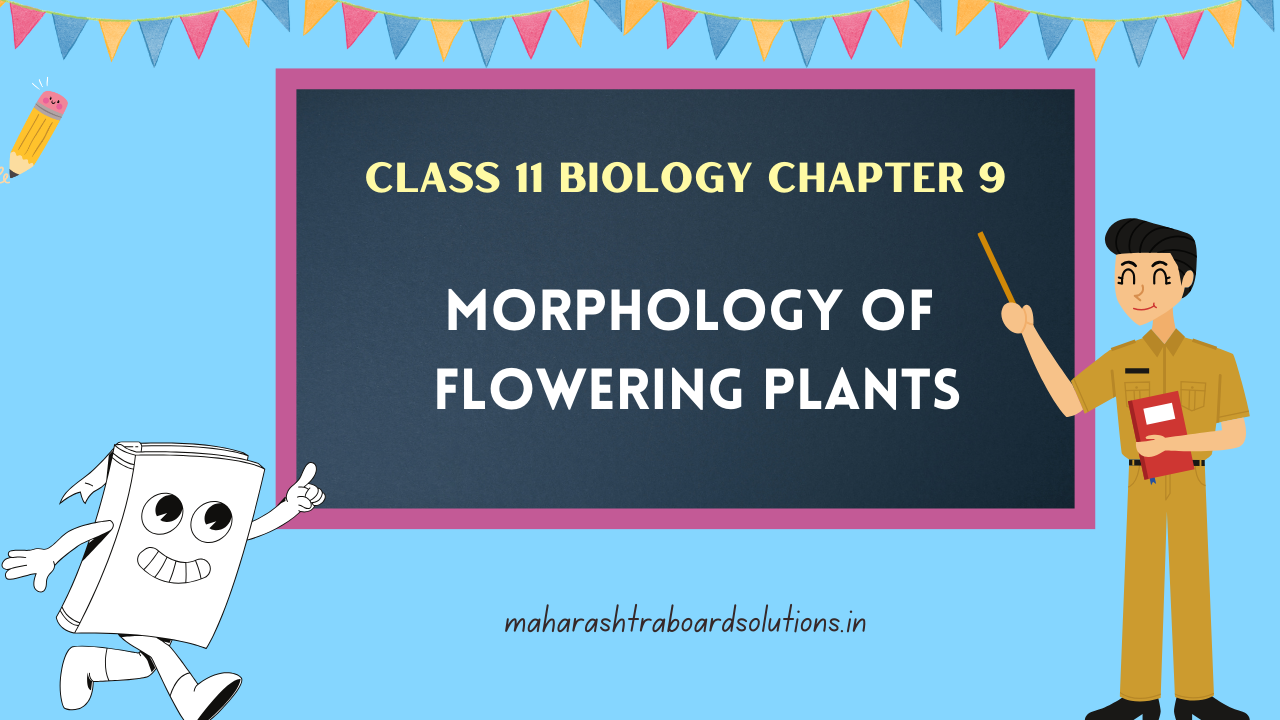Balbharti Maharashtra State Board 11th Biology Textbook Solutions Chapter 9 Morphology of Flowering Plants Textbook Exercise Questions and Answers.
Morphology of Flowering Plants Class 11 Exercise Question Answers Solutions Maharashtra Board
Class 11 Biology Chapter 9 Exercise Solutions Maharashtra Board
Biology Class 11 Chapter 9 Exercise Solutions
1. Choose correct option
Question (A)
Which one of the following will grow better in moist and shady region?
(a) Opuntia
(b) Orchid
(c) Mangrove
(d) Lotus
Answer:
(b) Orchid
![]()
Question (B)
A particular plant had a pair of leaves at each node arranged in one plane. What is the arrangement called?
(a) Alternate phyllotaxy
(b) Decussate phyllotaxy
(c) Superposed phyllotaxy
(d) Whorled phyllotaxy
Answer:
(c) Superposed phyllotaxy
Question (C)
In a particular flower the insertion of floral whorls was in such a manner, so the ovary was below other three whorls, but its stigma was taller than other three whorls. What will you call such flower?
(a) Hypogynous
(b) Perigynous
(c) Inferior ovary
(d) Half superior – half inferior
Answer:
(c) Inferior ovary
Question (D)
Beet and Arum both store food for perennation.
Are the examples for two different types?
(a) Beet is a stem but Arum is a root
(b) Beet is a root but Arum is a stem
(c) Beet is a stem but Arum is a leaf
(d) Beet is a stem but Arum is an inflorescence
Answer:
(b) Beet is a root but Arum is a stem
2. Answer the following questions
Question (A)
Two of the vegetables we consume are nothing but leaf bases. Which are they?
Answer:
Onion, Garlic
![]()
Question (B)
Opuntia has spines but Carissa has thorns. What is the difference?
Answer:
- In Opuntia, stem is modified into leaf like photosynthetic organ known as phylloclade.
- Spines growing on phylloclade of Opuntia are leaves, modified to reduce the loss of water through transpiration.
- Thoms in Carissa are modified apical buds. They provide protection against browsing animals.
- Thus, spines in Opuntia and thorns in Carissa have different origin and function.
Question (C)
Teacher described Hibiscus as solitary Cyme. What it means?
Answer:
1. In Cymose inflorescence, growth of peduncle is finite and it terminates into flower.
2. In Hibiscus, flower is borne singly at the tip of peduncle. Hence, teacher described Hibiscus as solitary cyme.
3. Write notes on
Question (A)
Fusiform root.
Answer:
Fusiform root:
1. Fusiform root is the modification of tap root for food storage.
2. Fusiform root:
The fusiform root is swollen in the middle and tapering towards both ends forming spindle shaped structure, e.g. Radish (Raphanus sativus)
![]()
Question (B)
Racemose inflorescence.
Answer:
Racemose inflorescence
Question (C)
Fasciculated tuberous root.
Answer:
Fasciculated tuberous root:
1. Fasciculated tuberous roots are modification of adventitious roots for storage of food.
2. Fasciculated tuberous roots do not develop any definite shape like modified tap roots.
3. a. A cluster of roots arising from one point which becomes thick and fleshy due to storage of food is known as fasciculated tuberous root.
b. These clusters are seen at the base of the stem, e.g. Dahlia, Asparagus, etc.
Question (D)
Region of cell maturation.
Answer:
Region of maturation/region of differentiation:
a. It is the uppermost major part of the root.
b. The cells of this region are quite impermeable to water due to thick wall.
c. The cells show differentiation and form different types of tissues.
d. This region helps in fixation of plant and conduction of absorbed substances.
e. Development of lateral roots also takes place from this region.
Question (E)
Rhizome.
Answer:
Rhizome:
- Rhizome is a modification of underground stem for storage of food.
- It is prostrate, dorsiventrally thickened and brownish in colour.
- It grows either horizontally or obliquely beneath the soil.
- Rhizome shows nodes and intemodes. It bears terminal and axillary buds at nodes.
- Terminal bud under favourable conditions produces aerial shoot which degenerates at the end of favourable condition.
- Growth of rhizome takes place with lateral buds, such growth is known as sympodial growth, e.g. Ginger (Zingiber officinale), Turmeric {Curcuma domestica), Canna etc.
- In plants where rhizomes grow obliquely, terminal bud brings about growth of rhizomes. This is known as monopodial growth, e.g. Nymphea, Nelumbo (Lotus), Pteris (Fern) etc.
- Rhizomes perform functions like storage of food, vegetative propagation and perennation.
![]()
Question (F)
Stolon.
Answer:
Stolons:
1. The slender lateral branch arising from the base of main axis is known as stolon.
2. In some plants it is above ground (wild strawberry).
3. Primarily stolon shows upward growth in the form of ordinary branch, but when it bends and touches the ground terminal bud grows into new shoot and develops adventitious roots.
e.g. Wild Strawberry, Jasmine, Mentha, etc. [Any one example]
Question (G)
Leaf venation.
Answer:
Leaf venation:
- Arrangement of veins and veinlets in leaf lamina is known as venation.
- Veins are responsible for conduction of water and minerals as well as food.
- The structural framework of the lamina is developed by veins.
- There are two types of leaf venation: parallel venation which is found in monocot leaves and reticulate venation which is found in dicot leaves.
Question (H)
Cymose inflorescence.
Answer:
Cymose inflorescence.
Question (I)
Perianth.
Answer:
Perianth (P):
a. Many times, calyx and corolla remain undifferentiated. Such member is known as tepal.
b. The whorl of tepals is known as Perianth.
c. It protects other floral whorls.
d. If all the tepals are free the condition is called as polyphyllous and if they are fused the condition is called as gamophyllous.
e. Sepaloid perianth shows green tepals, while petaloid perianth shows brightly coloured tepals. e.g. Lily, Amaranthus, Celosia, etc.
f. Petaloid tepal helps in pollination and sepaloid tepals can perform photosynthesis.
![]()
Question (J)
Write a short note on vexillary aestivation.
Answer:
Vexillary: Corolla is butterfly shaped and consists of five petals. Outermost and largest is known as standard or vexillum, two lateral petals are wings and two smaller fused forming boat shaped structures keel. e.g. Pisum sativum
Question (K)
Write a short note on axile placentation.
Answer:
Axile placentation: Placentation: The mode of arrangement of ovules on the placenta within the ovary is called placentation.
Axile: Ovules are placed on the central axis of a multilocular ovary, e.g. China rose, Cotton, etc.
Question 4.
Identify the following figures and write down the types of leaves arrangement.
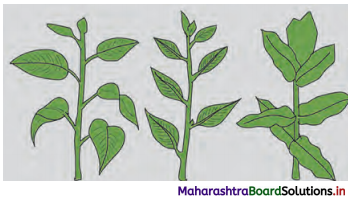
Answer:
1. The given figures represent phyllotaxy. It is the arrangement of leaves on the stem and branches in a specific manner.
2. Figure ‘a’ and ‘b’ represents, alternate phyllotaxy. In this type of phyllotaxy, single leaf arises from each node of a stem. e.g. Mango
3. Figure ‘c’ represents opposite decussate phyllotaxy. In this type of phyllotaxy, a pair of leaf arise from each node and the consecutive pair at right angle to the previous one. e.g. Calotropis.
5. Students were on the excursion to a botanical garden. They noted following observation. Will you be able to help them in understanding those conditions?
Question (A)
A wiry outgrowth was seen on a plant arising from in between the leaf and stem.
Answer:
A wiry outgrowth on a plant arising from in between the leaf and stem can be an axillary stem tendril. Stem tendrils:
a. Tendrils are thin, wiry, photosynthetic, leafless coiled structures.
b. They give additional support to developing plant.
c. Tendrils have adhesive glands for fixation.
![]()
Question (B)
There was a green plant with flat stem, but no leaves. The entire plant was covered by soft spines.
Answer:
Student must have observed phylloclade, which is a modification of stem.
Phylloclade:
a. Modification of stem into leaf like photosynthetic organ is known as phylloclade.
b. Being stem it possesses nodes and internodes.
c. It is thick, fleshy and succulent, contains mucilage for retaining water e.g. Opuntia, Casuarina (Cylindrical shaped phylloclade) and Muehlenbeckia (ribbon like phylloclade).
Question (C)
Many oblique roots were given out from the lower nodes, apparently for extra support.
Answer:
a. Students must have observed adventitious roots in monocotyledonous plants like maize, sugarcane, wheat, etc.
b. Adventitious roots develop from any part of a plant other than radicle.
c. In such plants, adventitious roots arise from the lower node of a stem and provide extra support to the plant. These roots are also called as stilt roots.
Question (D)
Many plants in the marshy region had upwardly growing roots. They could be better seen during low tide.
Answer:
a. Plants growing in marshy region (halophytes) produce upwardly growing roots called as
pneumatophores or respiratory roots.
b. The main root system of these plants does not get sufficient air for respiration as soil is water logged.
c. Due to this, mineral absorption of plant also gets affected.
d. To overcome this problem underground roots, develop special roots which are negatively geotropic; growing vertically upward.
e. These roots are conical projections present around main trunk of plant.
f. Respiratory roots show presence of lenticels which helps in gaseous exchange.
Question (E)
A plant had leaves with long leaf apex, which was curling around a support.
Answer:
a. Students must have observed leaf tip tendril.
b. In some weak stems, leaf apex modifies into thin, green, wiry, coiled structure called as leaf tendril.
c. Such leaf tendrils, help in climbing by curling around a support.
![]()
Question (F)
A plant was found growing on other plant. Teacher said it is not a parasite. It exhibited two types of roots.
Answer:
a. Student must have observed an epiphytic plants like Dendrobium, Vanda growing on other plant.
b. The two types of roots exhibited by this plant must be clinging roots and epiphytic roots.
c. Clinging roots:
1. Clinging roots are tiny roots develop along intemodes, show disc at tips.
2. It exudes sticky substance which enables plant to get attached to the substratum without damaging it.
d. Epiphytic roots:
1. Epiphytic plants like Vanda, Dendrobium grow on branches of trees in dense rain forests and are unable to obtain moisture from soil.
2. Such plants produce epiphytic roots which hang in the air.
3. The roots are provided with a spongy membranous absorbent covering of the velamen tissue.
4. The cells of velamen tissue are hygroscopic and have porous walls, thus they can absorb moisture from air.
5. Epiphytic roots can be silvery white or green and are without root cap.
Question (G)
While having lunch onion slices were served to them. Teacher asked which part of the plant are you eating?
Answer:
a. The edible part of an onion is fleshy leaves.
b. Onion is a bulb, in which stem is highly reduced, discoid and possesses adventitious roots at the base.
c. This stem bears a whorl of fleshy leaves which store food material.
d. The scale leaves or fleshy leaves are arranged in concentric manner over the stem. Some outer scale leaves become thin and dry. Thus, it is also called as tunicated or layered bulb.
Question (H)
Students observed large leaves of coconut and small leaves of Mimosa. Teacher asked it what way they are similar?
Answer:
a. Both large leaves of coconut and small leaves of Mimosa show pinnately compound leaves.
b. In both plants, leaf lamina is divided into number of leaflets.
c. Leaflets are present laterally on a common axis called rachis, which represents the midrib of the leaf.
Question (I)
Teacher showed them Marigold flower and said it is not one flower. What the teacher meant?
Answer:
a. Marigold flower is an inflorescence in which flowers are produced in a definite manner on a peduncle.
b. In Marigold, racemose type of inflorescence can be observed.
c. In this, peduncle condenses to form a flat rounded structure called receptacle.
d. Opening of flower centripetal i.e. younger flowers are towards the centre and open later, while older flowers towards the periphery and open first.
Question (J)
Students cut open a Papaya fruit and found all the seeds attached to the sides. Teacher inquired about the possible placentation of Papaya ovary.
Answer:
a. In Papaya, seeds are attached to the sides of a fruit. Thus, parietal placentation is possible in papaya ovary,
b. In parietal placentation, ovules are placed on the inner wall of unil unilocular ovary of multicarpellary, syncarpus gynoecium.
![]()
Question 6.
Match the following.
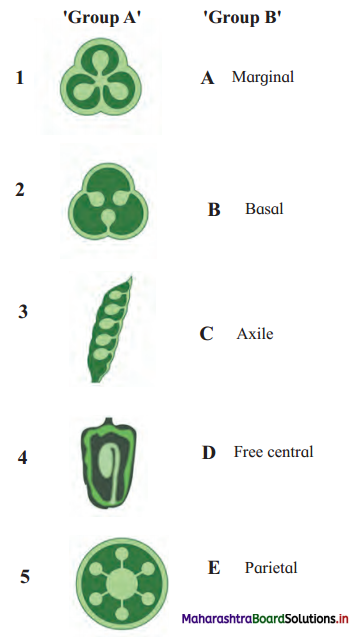
Answer:
(i-c-1), (ii-e-3), (iii-a-4), (iv-b-5), (v-d-2)
[Note: Another example of palmately compound leaf (Bifoliate) is Balanites roxburghii.]
Question 7.
Observe the following figures and label the different parts.
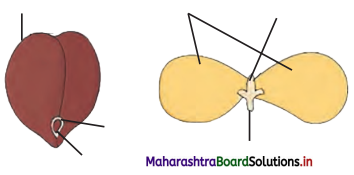
Answer:
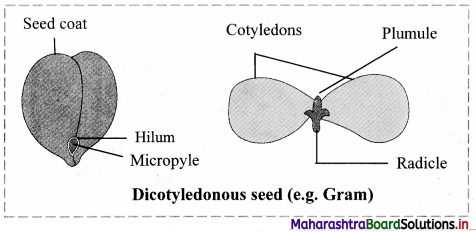
8. Differentiate with diagrammatic representation.
Question (A)
Differentiate with diagrammatic representation: Racemose and cymose inflorescence.
Answer:
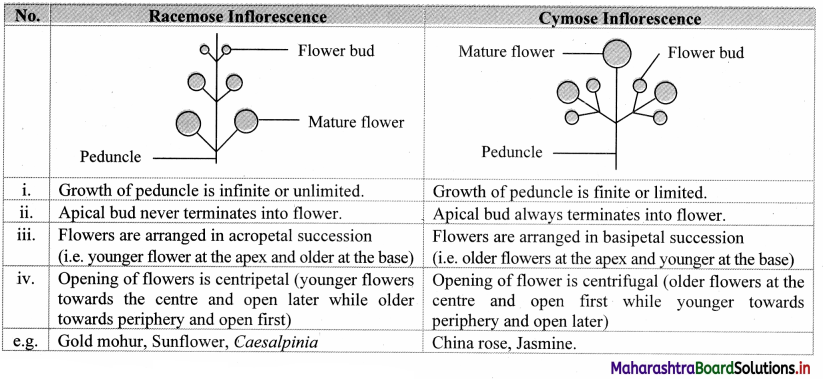
![]()
Question (B)
Differentiate with diagrammatic representation: Reticulate and parallel venation
Answer:
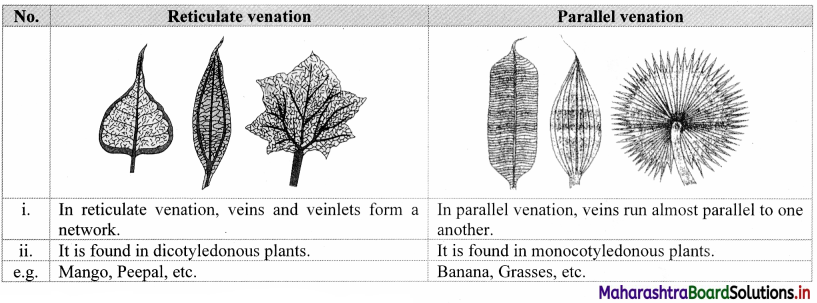
Question (C)
Differentiate with diagrammatic representation: Taproot and Adventitious roots
Answer:
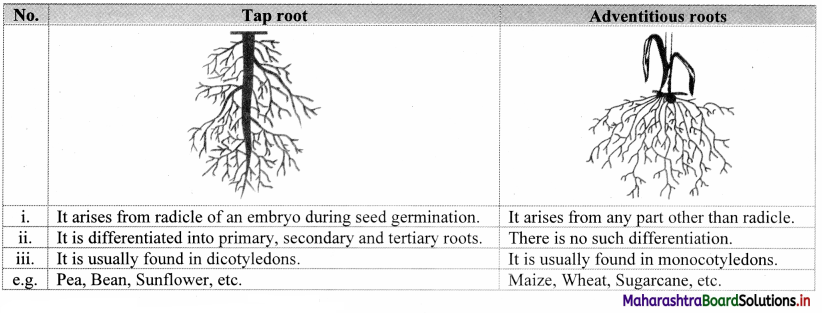
Practical / Project:
Question 1.
Collect different leaves from nearby region and observe variation in margin, leaf base, apex etc.
[Note: Students can scan the given Q.R code to study the different le
af margin, leaf base and apex.]
![]()
Question 2.
Find out and make a note of economically important plant from family Fabaceae, Solanaceae and Liliaceae.
Answer:
1. Economically important plant from family Fabaceae:
Family Fabaceae includes many pulses like gram, arhar, moong, soybean; edible oil seeds like soybean, groundnut; dye (lndigofera); fibres which can be obtained from Sun hemp, Sesbania trifolium which can be used as fodder; some plants are ornamental like lupin, sweet pea; some medicinal plants like muliathi.
2. Economically important plant from family Solanaceae:
Family Solanaceae includes many plants which are good source of food e.g. tomato, brinjal, potato; Spice e.g. chilli; Medicine e.g. belladonna, ashwagandha; Ornamental plants like Petunia.
3. Economically important plant from family Liliaceae:
Family Liliaceae includes many ornamental plants like tulip, Gloriosa, Medicinal plants like Aloe vera. Asparagus and source of colchicine, e.g. Colchicum autumnale.
Question 3.
Collect different leaves from garden and observe their veins and classify it.
11th Biology Digest Chapter 9 Morphology of Flowering Plants Intext Questions and Answers
Use your brainpower. (Textbook Page No. 102)
Why underground stem is different from roots?
Answer:
Underground stems are modified to perform different functions like storage of food, perennation and vegetative propagation. However, they differ from root in having nodes and intemodes.
![]()
Use your brainpower. (Textbook Page No. 104)
Why the stem has to perform photosynthesis in xerophytes?
Answer:
1. Xerophytes are the plants which grow in regions with scanty or no rainfall like desert.
2. In Xerophytes, leaves get modified into spines or get reduced in size to check the loss of water due to transpiration.
3. As the leaves are modified into spines, the stem becomes green in colour to do the function of photosynthesis.
Internet My Friend. (Textbook Page No. 106)
Collect information of types of leaf venation.
Answer:
1. Figure ‘R’ shows types of reticulate venation. WTien the veins and veinlets form a network, it is called
reticulate venation.
On the basis of number of mid-veins, reticulate venation is of two types:
a. Pinnate or unicostate: It is with single midrib e.g. Peepal, Mango.
b. Palmate or multicostate: It is with two or more prominent veins. It is further divided into convergent or divergent.
1. Multicostate convergent reticulate: Many prominent veins appear from the base of leaf lamina and converged in a curved manner towards the leaf apex. e.g. Zizyphus
2. Multicostate divergent reticulate: Prominent veins arise from the single point at the base of leaf lamina
and then diverge from one another towards the leaf margin, e.g. Cucurbita
2. Figure ‘P’ shows types of parallel venation. When veins run almost parallel to one another it is called parallel venation. It is of two types:
a. Unicostate: In this, lamina has single prominent mid vein from which many lateral parallel veins arise at regular intervals, e.g. Banana
b. Multicostate: In this, two or more mid veins run parallel to each other. It is further divided into convergent or divergent.
1. Multicostate convergent parallel:
Many prominent veins arise from the leaf base and then converge at leaf apex. e.g. Grasses
2. Multicostate divergent parallel:
Many prominent veins arise from the leaf base and then diverge towards margin, e.g. Borassus flabellifer (Toddy palm)
![]()
Observe and Discuss. (Textbook Page No. 112)
Observe and Discuss.
 Answer:
Answer:
1. Figure ‘a’ shows fruit of tomato.
- It is a simple fruit as it develops from a single flower with bicarpellary syncarpous gynoecium.
- It is a berry, because it has fleshy endocarp and many seeds.
2. Figure ‘b’ shows fruit of Custard apple.
- It is an aggregate fruit, because it develops from a single flower with polycarpellary, apocarpous gynoecium.
- Here, the ovary of each carpel gives rise to a part of the fruit called fruitlet. Hence, it is called an aggregation of fruitlets.
- Custard apple can be further described as Etaerio of berries.
3. Figure ‘c’ shows fruit of pineapple.
- It is a composite fruit, because it develops from a complete inflorescence.
- Pineapple can be further described as Sorosis, as it develops from catkin type of inflorescence.
4. Figure ‘d’ shows fruit of milkweed.
- It is a simple dehiscent dry fruit.
- It has many seeds. When pericarp becomes dry and thin, it breaks open by one ventral suture.
![]()
Activity. (Textbook Page No. 113)
Study the family Liliaceae, prepare a table of following characteristics.
Answer:
| Symmetry of flower | Actinomorphic |
| Bisexual/ Unisexual | Bisexual |
| Calyx | Absent |
| Corolla | Absent |
| Androecium | Stamens six, arranged in two whorls of 3 each, epiphyllous |
| Gynoecium | Tricarpellary, syncarpous, trilocular ovary with many ovules |
| Aestivation | Valvate |
| a. Calyx | Absent |
| b. Corolla | Absent |
| Placentation | Axile |
| Position of ovary | Superior ovary |
| Types of fruit | Capsule, rarely berry |
11th Std Biology Questions And Answers:
- Morphology of Flowering Plants Class 9 Biology Questions And Answers
- Animal Tissue Class 9 Biology Questions And Answers
- Study of Animal Type : Cockroach Class 9 Biology Questions And Answers
- Photosynthesis Class 9 Biology Questions And Answers
- Respiration and Energy Transfer Class 9 Biology Questions And Answers
- Human Nutrition Class 9 Biology Questions And Answers
- Excretion and Osmoregulation Class 9 Biology Questions And Answers
- CSkeleton and Movement Class 9 Biology Questions And Answers
